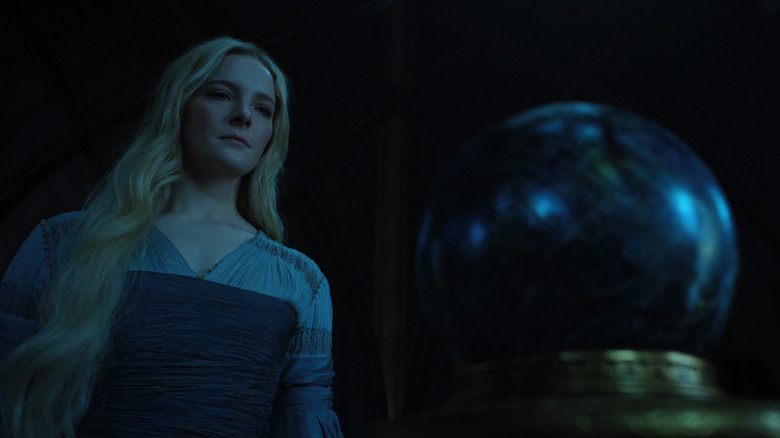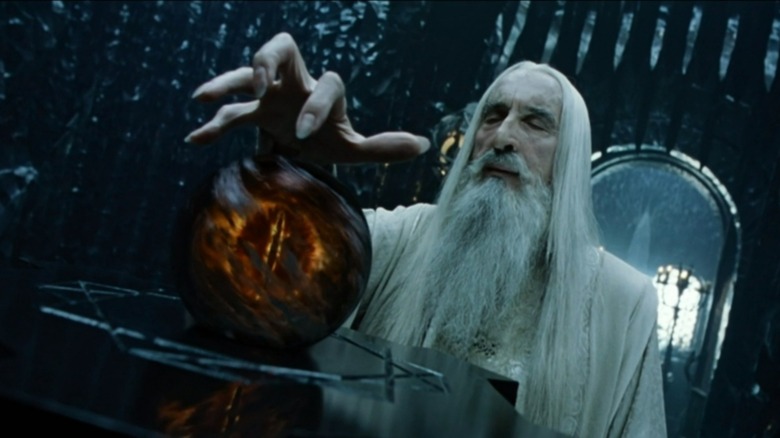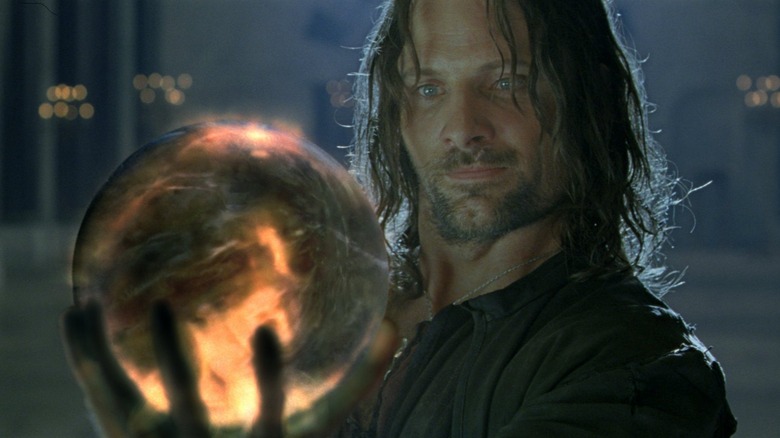Where You've Seen That Seeing Stone In The Rings Of Power Before
In the singular world of Middle-earth, you just never quite know what you'll stumble upon next. Author J.R.R. Tolkien created such an unimaginably huge and fully lived-in universe that readers always had to stay on their toes. At any given moment, fans could anticipate the introduction of fascinating new settings and wild fantasy concepts (and maybe a jarring and divisive character or two) unlike anything else in the genre. Considering the thousands of years of history that Tolkien made up from scratch, the creators behind "The Lord of the Rings: The Rings of Power" faced an uphill battle to make all of this digestible to mainstream audiences. That's what makes it all the more remarkable that the last episode neatly (re)introduced a certain object that fans have definitely seen before.
Episode 4, titled "The Great Wave," takes a wide-ranging look at all the major characters now scattered across the land, but one moment stands out the most for the ramifications it may have on the rest of the series. While Galadriel (Morfyyd Clark) and Míriel (Cynthia Addai-Robinson) attempt to reach an understanding over how to deal with her unwelcome intrusion to the isolationist island kingdom, the Númenorean queen regent unveils a particularly striking object that she refers to as a Seeing Stone – a palantír (which means "far sighted" in the fictional language of Quenya that Tolkien invented) that was originally one of seven.
Of course, those who know their lore recognize just how significant these objects will become in the Third Age during the events of "The Lord of the Rings." For those in need of a refresher, that's what we're here for! These powerful items come with a fascinating backstory and, as we'll undoubtedly see in the weeks to come, plenty of untapped potential to fully explore in "The Rings of Power."
Warning: Spoilers ahead for "The Lord of the Rings: The Rings of Power."
The palantíri explained
As much as hardcore fans can never get enough of Tolkien's dense world building, filled with vast amounts of detail that would make the obsessive moderators over at Wookieepedia break out into a cold sweat, such a massive universe posed certain problems for the author. For one thing, how do you make characters exchange information, perceive distant threats, and become aware of all sorts of prophecies and visions across such distances? Enter the palantíri, a series of impossibly well-crafted stones that allow their users to peer across time and space — in ways that they never may have anticipated.
So how do such powerful objects come into being in the first place? As is usually the case with Tolkien, you can thank (or blame!) the elves.
The palantíri were created by the Noldor elves who lived in Valinor in the First Age, traditionally credited to the handiwork of Fëanor himself. We've heard that name invoked once before on "The Rings of Power," when Elrond (Robert Aramayo) and Celebrimbor (Charles Edwards) discussed the legendary elf's craftwork of the precious Silmaril gems that woke the jealousy and lust of the villainous Morgoth. As Míriel explains to Galadriel, a total of seven palantíri were commissioned, but all the others have been "lost or hidden" by this point in history — except for one, now in possession of the Númenoreans and eventually handed down to the queen from her father.
As Galadriel finds out for herself, this gave the queen her prophetic vision of the destruction of the kingdom by the sea ... but is that fate set in stone? The way the palantíri were used in "The Lord of the Rings" might answer that question.
Don't believe everything you see
One look at the way that the palantíri are depicted in the original trilogy reveals just how deceptive and ominous these seeing stones can be.
By the time our heroes in "The Lord of the Rings" come onto the scene, almost all of the palantíri have been lost to the ravages of history in the preceding ages. The one we see in "The Fellowship of the Ring" comes under the care of the corrupt wizard Saruman, who plumbed the depths of his palantír and became seduced by Sauron's influence (who also had one in his own possession). In "The Return of the King," the hobbit Pippin is victimized by his own recklessness and accidentally reveals himself to Sauron when he gets a little too curious. The extended edition includes one fan-servicey scene that shows Aragorn picking up the same stone and fully revealing himself to Sauron, this time in outright defiance of the dark lord. In the books, the Steward of Gondor Denethor is also revealed to have kept another one in the Gondorian city of Minas Tirith. The carefully manipulated images he saw caused him to lose all hope of achieving victory over Sauron altogether and made the realm even more susceptible to defeat.
Although Gandalf claims in the books that the palantíri don't outright "lie," the use of such stones remains ill-advised because nobody knows who else is controlling the others and twisting things to their own devious ends. These cautionary tales at least provide some clues of what to expect in "The Rings of Power," with the queen's visions of Númenor's downfall potentially turning into a self-fulfilling prophecy.
New episodes of "The Lord of the Rings: The Rings of Power" stream on Prime Video every Friday.


